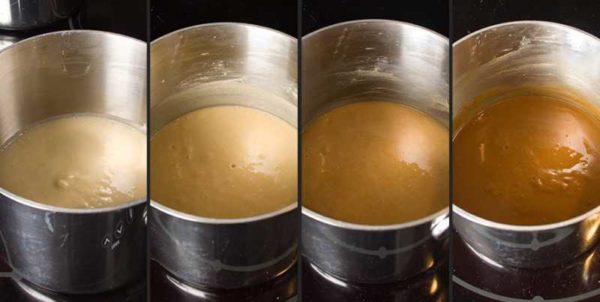White, Blond, Brown Roux

A Little Personal History
Forget corn starch and other thickening agents, roux is the tried and try best way to thicken sauces, avoiding any of that “chalky” flavor. Here’s how to make all three varieties.
A Roux (pronounced “ROO” as in rooster) is the basis for most stews and gumbos. Roux may also be added to gravies to thicken. It consists of equal parts of flour and oil. Here”s how it”s done.
"https://en.wikipedia.org/wiki/Roux"
Chef Lars
Instructions
- Depending on what type of roux you”re preparing:
- White Roux: heat clarified butter in large skillet over medium heat.
- Blond Roux: heat butter in large skillet over medium heat.
- Brown Roux: heat canola or soybean oil in large skillet over medium-high heat
- Add flour whisking vigorously. When mixture thins and starts to bubble, reduce heat to low and cut back on the whisking.
- Over low heat, depending on what type of roux you”re preparing:
- White Roux: Cook until you smell a toasty aroma then cook 2 minutes more, stirring occasionally.
- Blond Roux: Cook until you smell a toasty aroma then cook 5 minutes more, stirring occasionally.
- Brown Roux: Cook until you smell a toasty aroma then cook till it begins to brown, stirring occasionally
- Allow roux to cool to room temperature
- On wax paper spread cooled roux and roll into approximately 1-inch circumference.
- Tightly seal with plastic wrap.
- Freeze for future use.
Recipe Notes
Advanced Preparation:
The good news is everything can be prepared in advance and frozen till needed.
Tips, Notes, and Variations:
- All roux needs to be cooked long enough for the taste of flour to be gone with just a slight “nutty” aroma.
- Roux can be used immediately to thicken a liquid that is at or below room temperature. To thicken a hot liquid, allow roux to cool to room temperature, or refrigerate.
- Tightly wrapped, roux can be refrigerated for up to a month. Simply break off pieces and use as needed.
- A good roux will have a slight shine to it, and neither the texture nor the taste of the flour will be apparent.
- White roux is used for milk-based sauces and for thick soups. It is cooked only until it no longer has a raw taste and has a frothy and slightly gritty consistency, but hasn”t begun to darken in color.
- Blond roux is used for sauces based on white stocks. It is cooked slightly longer than white roux to give it a deeper color. A blond roux is great for sauces to go with fish or seafood, especially crab and shrimp, because it takes a nice orange, coral-like color when mixed with cream.
- Brown roux, needs to be cook at slightly higher heat, decreasing cooking time. Therefore, use canola, soybean or other oils that have a higher heat point. If you”ve only got butter handy (unsalted), cook longer at lower heat and increase heat slowly until it browns.


You must log in to post a comment.